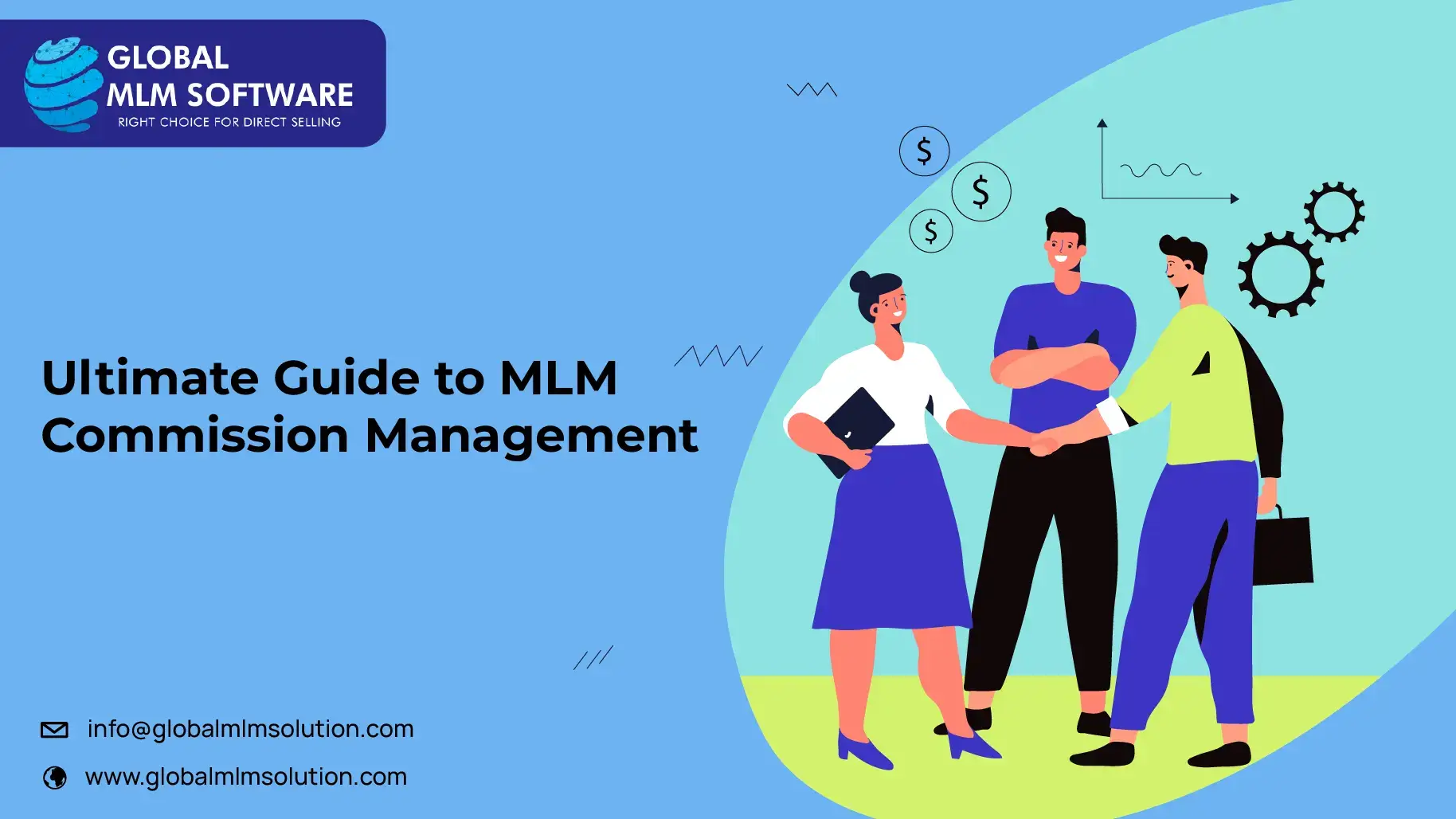Summary
Discover how to achieve sustainable growth in your MLM business through effective rank advancement. This step-by-step guide explains what rank advancement is, the key metrics to track, its role in compensation plans, real-world case studies, and practical strategies to overcome common challenges.
Commission, Check! Bonuses, Check! Rewards, Check! What else can you do to motivate your distributors? One of the key elements that you are missing out on is MLM rank advancement.
You are paying commission to the distributors on the sales they and their respective teams bring to the business. Once in a while, when they meet their monthly or lifetime sales targets, you provide them with bonuses. You also reward your exceptional distributors with trips and event access.
So far, so good.
However, why don’t you gamify the compensation even further by introducing MLM rank advancement? It allows distributors to view leveling up as access to better earnings, more recognition, and faster growth.
Let’s learn what it is, how to set it up, and why it’s a must-have.
This Article Contains:
What is Rank Advancement in MLM?
MLM Rank advancement is a part of the MLM compensation plan that allows distributors to achieve higher positions within the MLM company, which unlocks better perks, such as higher commissions and bonuses.
Distributors need to pass the criteria, such as overall personal sales volume, team sales volume, number of team members, title maintenance, customer count, etc., to move to the next level.
Once distributors achieve a rank, they advance by completing the requirements for the next higher rank and then the next one, and so on. MLM rank advancement provides them with a clear objective and a transparent sense of where they stand. They can continue moving forward till they achieve the highest one. A very few of all distributors reach that point, but that rarity makes the achievement truly meaningful.
Let’s take an example of doTERRA here.
There are twelve levels in Doterra, where a distributor joins as a Wellness Advocate and can reach up to the Presidential Diamond level.
4% of total distributors reached the Elite rank, which is the 8th highest. As they move forward to Premier, Silver, Gold, Platinum, and Diamond, the total qualified people are reduced to 1%, 0.6%, 0.2%, 0.1%, and 0.1%, respectively.
The top two ranks, which are Presidential Diamond and Blue Diamond, are achieved by less than 0.1% of people.
So, as you can see, it’s not that tough to become an Elite rank distributor; in every twenty-five members, there’s one. However, the plan is designed in such a way that it takes exceptional effort to reach the top.
| dōTERRA MLM Rank Advancement & Attainment Rates | ||
|---|---|---|
| Rank | Name of the Position | Percentage of Distributors Achieved the Rank |
| 1–4 | Wellness Advocate to Executive | More than 4% |
| 5 | Elite | 4% |
| 6 | Premier | 1% |
| 7 | Silver | 0.6% |
| 8 | Gold | 0.2% |
| 9 | Platinum | 0.1% |
| 10 | Diamond | 0.1% |
| 11 | Blue Diamond | Less than 0.1% |
| 12 | Presidential Diamond | Less than 0.1% |
Source: doTerra’s BILD Business Brochure
The Key Metrics for MLM Rank Advancement
Rank Advancement works best when it depends on multiple factors. If a single KPI flips the switch, people will figure out how to game it, compliance risk will rise, and the plan can become unsustainable.
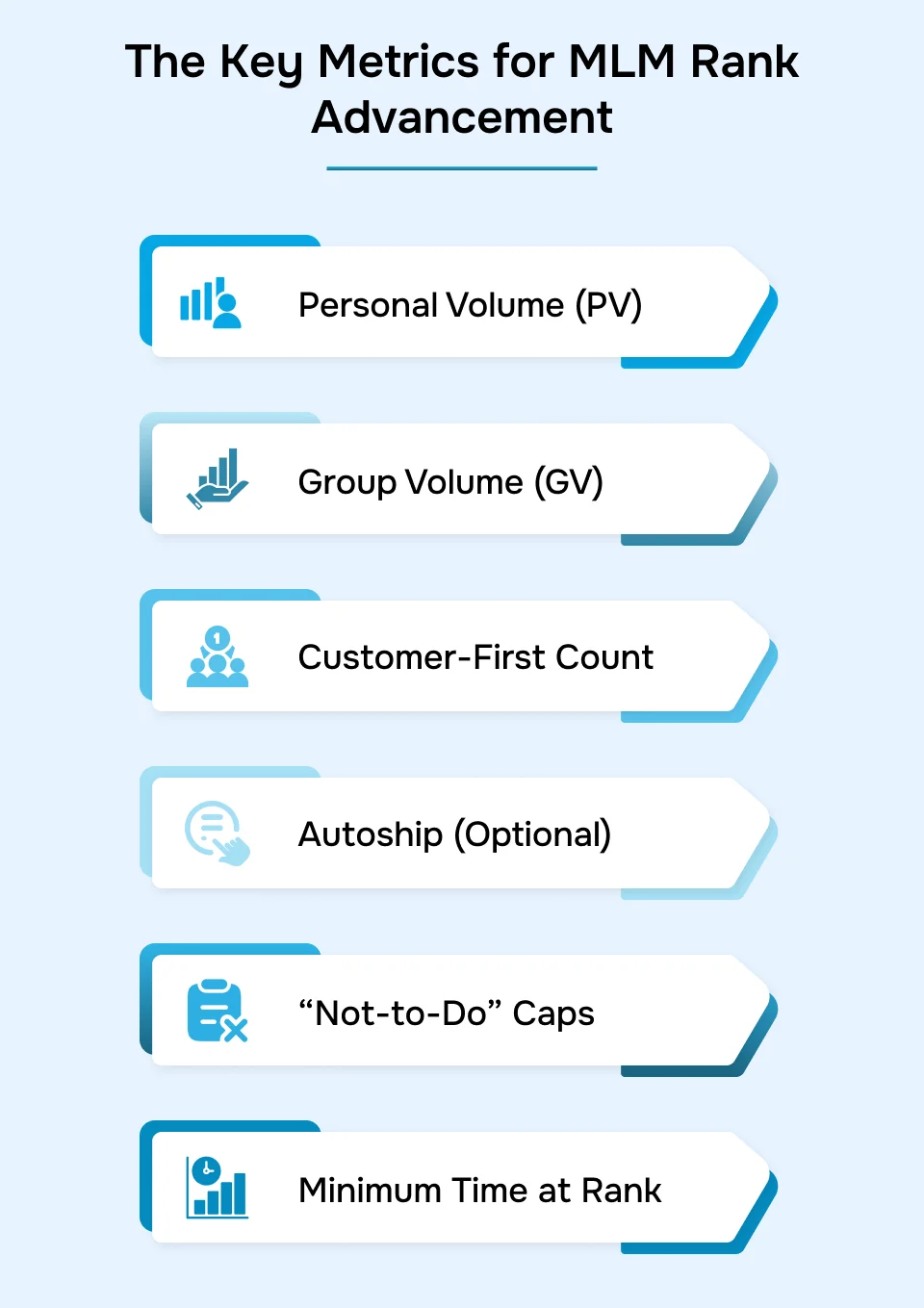
For instance, if the rank advancement only depends on sales, a few distributors may inflate the orders to achieve the rank for better perks. Similarly, if it solely depends on recruitment, your business will be considered noncompliant. The fix is simple. You should use a balanced set of metrics, give each one a clear target, and tie them together at every rank.
| Rank Advancement: Common Metrics that MLM Businesses Follow | |||||
|---|---|---|---|---|---|
| KPI | What it measures | Why it matters | How to set it | Example rule | Notes |
| Personal Volume (PV) | Distributor’s own qualified sales in a period | Proves real activity, effort, and product movement | Set monthly PV floors that rise with rank | PV is greater than $X, and retail share is greater than 60% | Use smaller PV jumps at higher ranks (leaders spend more time on mentoring & GV) |
| Group Volume (GV) | Qualified sales from the distributor’s team (directs + their recruits) | Rewards leadership, coaching, and duplication | Increase GV linearly/exponentially by rank; align with payout budget | GV is greater than $Y across | Publish per-leg caps to avoid one “super-leg” carrying rank |
| Customer-First Count | Unique retail customers and retail orders | Anchors plan for real buyers and prevent inventory loading | Minimum URC and retail orders per period | More than 5 unique customers and more than 10 retail orders per month | Track retail share of PV (e.g., ≥60%) for compliance |
| “Not-to-Do” Caps | Chargebacks, refunds, and excessive support tickets | Filters out unhealthy selling and protects customer experience | Set ceilings that pause advancement when exceeded | Chargebacks less than 0.2%; Returns less than 5%; Complaints ≤ 1.5% | Make rules transparent and include a review/appeal path |
| Minimum Time at Rank | Required active period before advancing | Signals “not a get-rich-quick” and stabilizes costs | Rolling windows with grace logic | Paid at rank for 2–3 months or more to advance | Documents compliance posture (FTC-friendly language) |
| Autoship (Optional) | Active, recurring retail customer subscriptions | Improves predictability and retention | Modest autoship count or retention target | More than 3 autoship customers; more than 70% autoship retention (3 cycles) | Don’t over-optimize and keep it consumer-friendly |
Let’s discuss these metrics in detail.
1) Personal Volume (PV) thresholds
Personal Volume means the distributor’s own qualified sales for the period. It is one of the essential KPIs, as it signifies real activity, efforts, product movement, and profit.
A minimum PV should be set for MLM rank advancement, as it will keep the distributor active even after achieving a higher rank. For initial ranks, you can set a low PV requirement and increase it for the higher ranks. However, decrease the increment gap between ranks at higher levels. That’s because higher-level distributors focus more on team building, mentorship, and group VP.
Consider this sample graph of PV vs. Rank, where one PV = $1 of sales.
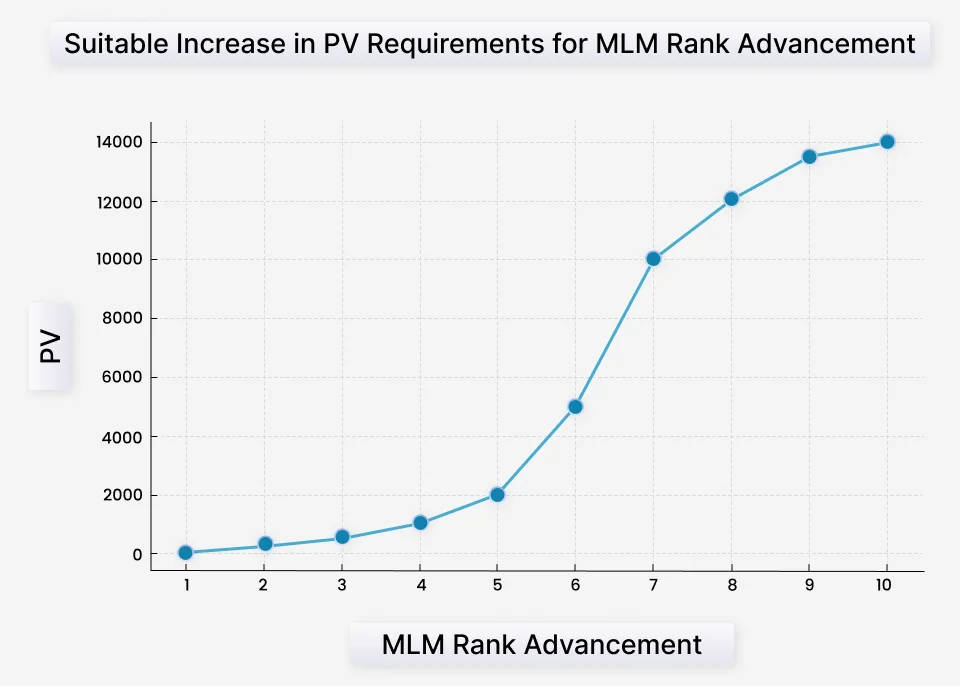
2) Group Volume (GV) thresholds
Group Volume means the total qualified sales by a distributor’s team, i.e., direct recruits and their recruits. GV metrics show that the distributor is not only making sales but also mentoring others as well.
Unlike PV, you can and should increase group volume requirements linearly or exponentially in the MLM rank advancement. That’s because, as the distributor rank goes, generally, the team grows as well. Such a system encourages the distributor to keep their recruits active and helps the MLM business get better sales.
3) Customer-first rules: minimum retail orders/customers count
When you run an MLM business, keeping customers and customer sales at the core is essential. When there is PV and GV, but the number of customers is limited, that means total sales are being made to a few customers.
When you keep customer count as a metric, distributors focus on engaging new customers as well, along with the existing ones.
This metric also helps you keep a check on non-compliance. If sales are high but not the customer count, there is a chance that fake sales or inventory loading has taken place for MLM rank advancement.
But with this metric in place, distributors are left with no motive to do the aforementioned non-compliance activities.
Apart from customer count, the number of MLM Autoships is also a rank advancement KPI that businesses include. It helps you increase the MLM business’s predictable income.
4) Chargebacks and Support Requests
Instead of only a “to-do” list, you can include “not-to-do” items or certain caps as MLM rank-advancement KPIs, too. Here, we are speaking of limits on support requests and chargebacks.
If the number of refund requests and support queries crosses a certain number, you can restrict the distributor’s rank advancement. It will ensure that only genuine distributors move forward.
At the same time, it helps in keeping customer satisfaction at the top, as distributors will be careful while selling and handling customers.
5) Minimum time on one rank
MLM rank advancement is not only a motivational tool but also supports keeping your business compliant with FTC laws and regulations.
When you keep a minimum active period needed for rank advancement, it’s proof that you don’t portray it to be a “get-rich-quick” scheme. And when there’s such a metric, distributors will also stay and make realistic goals and won’t conduct non-compliant activities for getting quick sales.
Let’s have a look at Amway’s rank progression and the time needed to advance every step:
| Rank | Minimum Period to Reach Next Level |
|---|---|
| Silver Producer | 3 Months as Silver Producer |
| Gold Producer | 6 Months as a Silver Producer in one performing year; 3 months must be consecutive at least once. |
| Platinum Producer | Qualify as a Silver Producer for 12 consecutive months. |
| Founders Platinum | No time limit, only PV requirements |
| RUBY | Satisfy RUBY’s PV requirements for 12 consecutive months. |
| FOUNDERS RUBY | Not applicable, as there’s no rank ahead |
Source: Amway Business Reference Guide
Benefits of Including MLM Rank Advancement as Part of Compensation Plan
MLM Rank Advancement benefits go beyond motivating your distributors. Along with rewarding your MLM distributors, it also supports your business by improving customer experience, compliance, and profits.
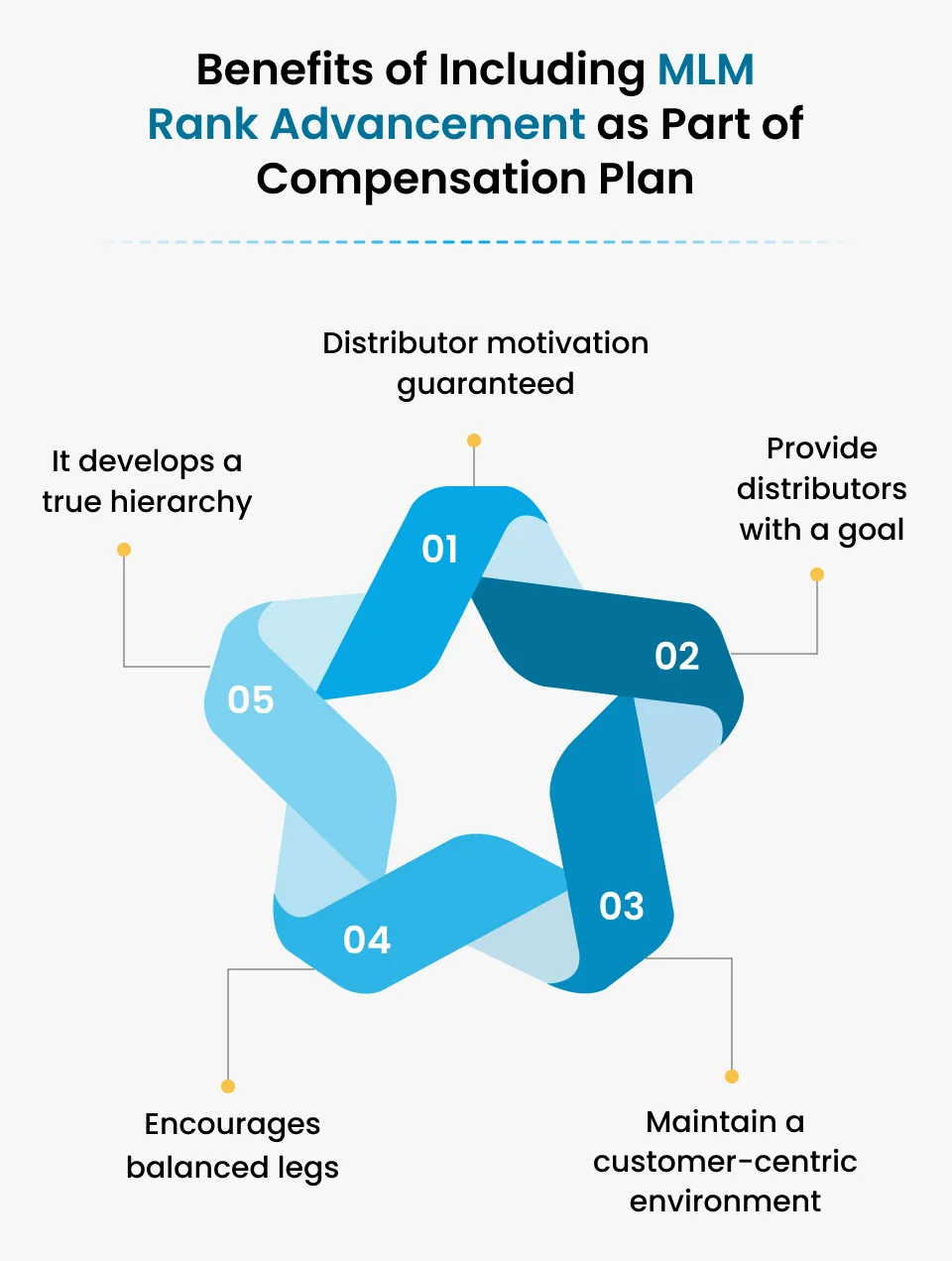
| MLM Rank Advancement as Part of Compensation Plan: Advantages You Should Know | |
|---|---|
| Benefit | Details |
| Distributor motivation guaranteed |
• Recognition & status milestones (badges/titles) • Tangible perks: higher commissions, bonuses, event access • Frequent progress checkpoints that keep momentum |
| Provide distributors with a goal |
• Clear next-rank targets (PV/GV/legs) visible to all • Weekly scorecards & checkpoints to track progress • 30–90 day sprint plans with mini-milestones |
| Maintain a customer-centric environment |
• Minimum unique retail customers/month as a KPI • Onboarding + usage tips + reorder reminders • Support quality metrics (low tickets/returns, fast response) |
| Encourages balanced legs |
• Binary payout on lower-volume (“weak”) leg; per-leg caps • Rank KPIs include left–right balance thresholds • Smart placement & coaching to stabilize both legs |
| It develops a true hierarchy |
• Performance-based ranks, not join date or sponsor position • Ability to earn more and outrank uplines on merit • Transparent criteria + public recognition for achievement |
1) Distributor motivation guaranteed
The primary reason why MLM rank advancement exists is to motivate distributors.
According to the Direct Selling Education Foundation report, Professional and Personal Benefits of a Direct Selling Experience, 57% of males and 39% of females confirm that they joined a direct selling business to receive recognition for their sales efforts. The percentage shows that recognition is not optional.
Beyond the applause, climbing the ranks comes with practical benefits, including bigger commissions, performance bonuses, and access to events, which make the journey worthwhile.
2) Provide distributors with a goal
When a distributor joins your MLM business, they will get familiar with the products, take the training, go through the resources, and start selling.
Now, they sell, earn, recruit, build a team, earn more, and repeat. But what’s the goal? What should be their target?
When an MLM rank advancement system is present, distributors will always know their next step.
3) Maintain a customer-centric environment
Direct selling rank advancement must include customer-centric KPIs, such as customer count or a low number of support requests. It keeps distributors’ activities in check so that they are making real sales, engaging with new customers, and keeping customer experience up to the mark.
It allows MLM businesses to keep their existing customers satisfied and new customers excited. With such an environment, businesses not only earn better profits but also come up as a trustworthy brand.
4) Encourages balanced legs
This benefit is exclusive to the binary MLM plan, where distributors have two legs: right and left. When a distributor enrolls someone, they are added to the left or right team. The payout is calculated as per the leg with less volume that week or month (often called the ‘weak leg’).
Many Binary MLM companies use balanced legs (threshold on the gap between right and left legs) as a direct selling rank advancement KPI. When the gap is greater than the threshold, the distributor doesn’t move to the next rank.
Therefore, distributors equally focus on both legs, ensuring that they maintain similar earnings.
Without rank advancement, there is only upline and downline that define the hierarchy. Like A sponsored B and B sponsored C, and so on. But should it be truly considered a hierarchy?
What if C earns more than B or even A? Should they be considered as “recruit of B” or “part of A’s downline?” The level system takes away the recognition, even when distributors make the required effort. It gives the message “The one who joined first will be of higher rank.”
Rank advancement breaks it.
It allows distributors to create their presence in the network. So, even when someone sponsors a distributor, they can still make more earnings than them and reach a higher rank, complementing their effort.
5) Develops a true hierarchy
Without rank advancement, there is only upline and downline that define the hierarchy. Like A sponsored B and B sponsored C, and so on. But should it be truly considered a hierarchy?
What if C earns more than B or even A? Should they be considered as “recruits of B” or “part of A’s downline”? The level system takes away the recognition, even when distributors make the required effort. It gives the message, “The one who joined first will be of higher rank.”
Rank advancement breaks it.
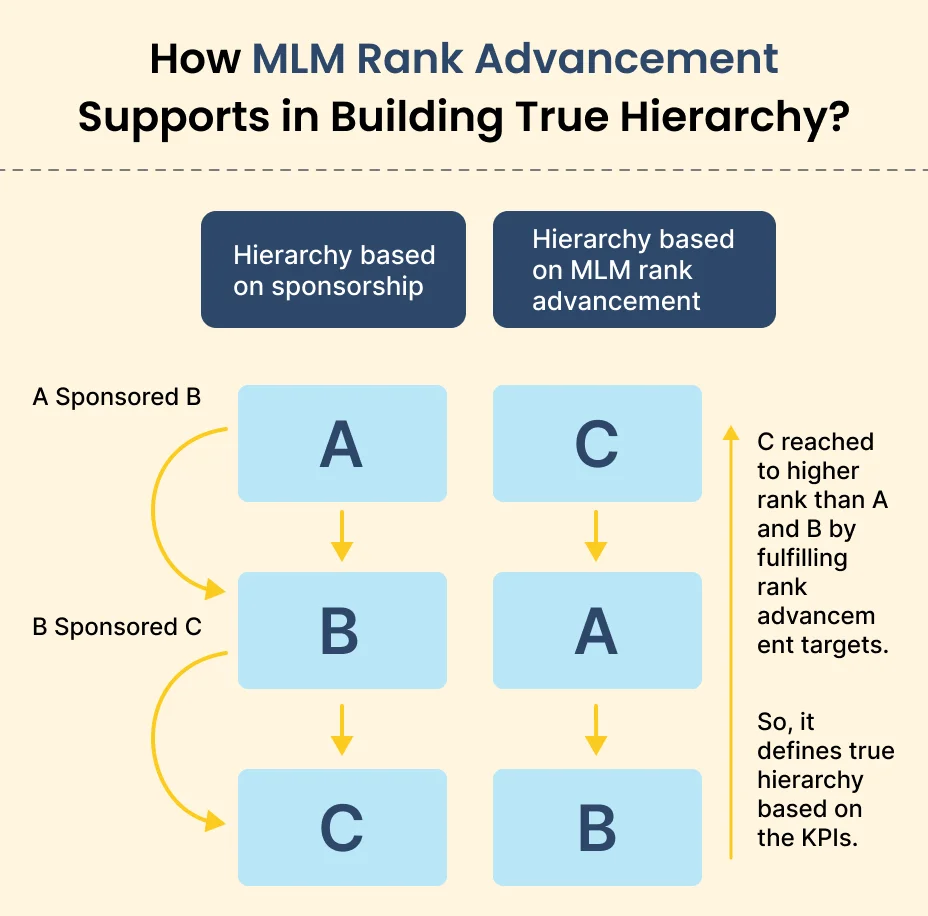
An In-depth Case Study on MLM Rank Advancement
Almost every MLM company has implemented a rank advancement as a part of its compensation plan.
Some companies have kept it simple. For instance, Usana distributors only need to complete commission targets (CPV requirements) to upgrade their rank.
They become a Sharer by earning 50 CPV/week. Then, they move to Believer when they start making 100 CPV/week. The highest level is the 11-Star Diamond, which requires 15,000 CPV/week to qualify.
On the other hand, there are businesses that mix up the KPIs to make direct selling rank advancement more challenging and interesting for their distributors.
LifeVantage's MLM rank advancement plan depends on three key performance indicators:
Sales Volume Requirement
Group Sales Volumen
Maximum Volume Rule
A distributor starts as a Consultant and can climb fourteen steps to become a Presidential Consultant.
They have kept the personal sales volume requirement for Consultants as 150 PV. It increases to 300 PV after climbing 4 steps to Senior Consultant 1 and stays the same till the top.
Therefore, this qualification is only to ensure that the distributor is active. LifeVantage has not increased the PV as it allows distributors to focus on team-building activities, which brings us to the next KPI.
When Consultants move to the next step to the Consultant 1 rank, they need to start focusing on group sales. At this rank, 500 GSV is required to qualify for the next step. To reach the top rank, Presidential Consultant, distributors need 1,000,000 GSV.
Look at the graph below that shows how GSV increases at each rank in the LifeVantage compensation plan.
The next KPI, the maximum volume rule, sets the maximum percentage of qualifying volume that can come from personal purchases made by the distributor and its team. It ensures that more purchases are made by end customers than distributors.
The third KPI keeps fraud and manipulation of the rank advancement system in check. If you allow 100% personal purchase, a few distributors can make all the pending purchases themselves just to qualify for the next level.
And you would also want to ensure that your MLM business does not fall under the Federal Trade Commission’s scrutiny. When maximum purchases are made by distributors themselves, it leads to non-compliance.
Making more sales to end customers than personal purchases is an essential point in the MLM compliance checklist.
The Common Challenges in MLM Rank Advancement and How to Overcome Them
Many MLM companies roll out a rank-advancement system and then keep changing it. Iteration is healthy, but the launch must be smooth and consistent.
Build the rules to reflect the behaviors you want, such as real customers, balanced teams, and steady activity. Expect setup challenges and solve them before you go live.
Use the points below to start strong.

- 01
Impractical or tough targets
You can keep tougher targets for higher ranks. But if you expect first-year distributors to achieve big, they will fail without experience and a team. Therefore, keep the progression curve gentle and make it steeper as distributors keep on achieving ranks.
- 02
Demotivation when the target is not achieved
When the goal is missed by a few inches, it hurts more than making no effort. Therefore, have an internal understanding of bending rules and allow a grace period or PV. If distributors made a genuine effort, welcome them to the next level.
- 03
Focus on new customers only
When PV is one of the KPIs, distributors will focus only on sales. However, post-purchase customer experience is equally important. Therefore, to balance the focus, put a “limit on chargebacks and support request numbers” to qualify for the next level.
- 04
Complicated rank rules
When there are numerous KPIs, it may become complicated for a distributor to understand the target. This leaves them with zero clue whether they are going to move forward or not. Keep things simple and provide compensation plan training.
- 05
Data blind spots
If you don’t provide distributors with tools to check team sales and growth, they won’t be able to track GSV manually. It’ll be too hectic. Using a platform like Global MLM Software, which provides an exclusive dashboard for each distributor, from which they can check their own and team members' earnings.
- 06
Ethics and compliance issues
Some distributors will care more about rank advancement than ethics. But they should go hand in hand. Set customer-related KPIs so they can’t conduct inventory loading or sell products to recruits unnecessarily. Compliance should also be a part of MLM training.
Key Takeaways
MLM rank advancement is not a fancy ladder. It’s the path designed for distributors to stay motivated, achieve more, and get recognized.
If you are thinking of implementing rank advancement for your MLM business, have no second thoughts. It’s needed, and it’s effective.
Keep a balanced mix of KPIs while keeping things simple. Take MLM compliance into consideration and don’t focus only on recruitment.
As soon as your plan goes live, you’ll find your distributors already motivated and working towards the target.
FAQs
1. What are the key factors for rank advancement in MLM?
There are several key factors for rank advancement in MLM, such as personal sales volume, group sales volume, customer count, new customers, etc.
2. What strategies can distributors use to achieve rank advancement?
The strategy that distributors can use to achieve rank advancement highly depends on the compensation plan and rank advancement targets. Making continuous efforts and segmenting the pin target into smaller steps is most important.
Disclaimer: Global MLM Software does not endorse any companies or products mentioned in this article. The content is derived from publicly available resources and does not favor any specific organizations, individuals or products.






